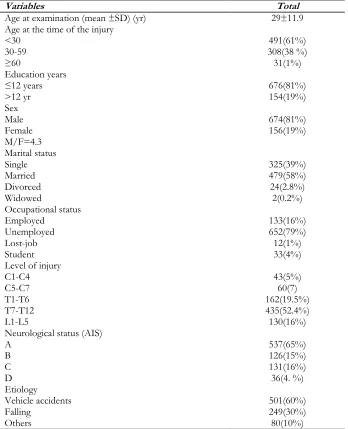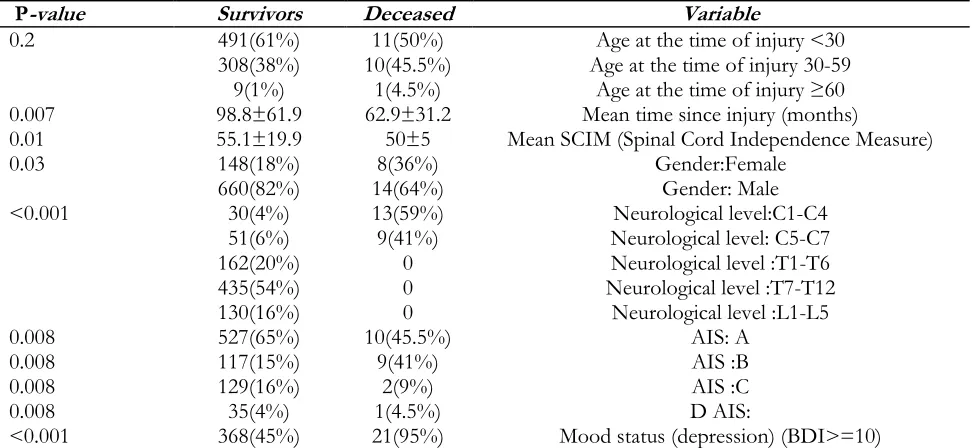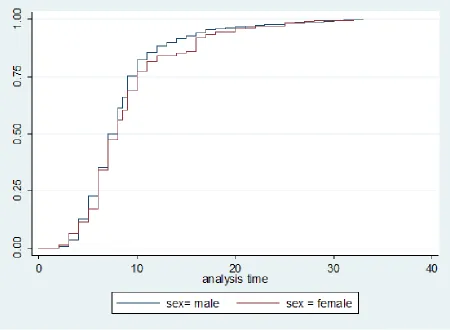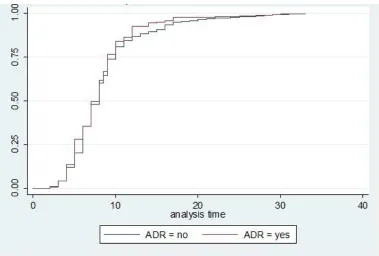Iran J Public Health, Vol. 48, No.12, Dec 2019, pp.2260-2269
Original Article
Survival Analysis in Patients with Chronic Traumatic Spinal Cord
Injury
Mahsa GHAJARZADEH
1, Abbas RAHIMI FOROUSHANI
2, Saharnaz NEDJAT
3,
Abdolreza SHEIKHREZAEI
4, *Hooshang SABERI
1,41. Brain and Spinal Cord Injury Research Center, Tehran University of Medical Sciences, Tehran, Iran
2. Department of Epidemiology and Biostatistics, School of Public Health, Tehran University of Medical Sciences, Tehran, Iran 3. Department of Epidemiology and Biostatistics, School of Public Health, Knowledge Utilization Research Center, Tehran University
of Medical Sciences, Tehran, Iran
4. Department of Neurosurgery, School of Medicine, Tehran University of Medical Sciences, Tehran, Iran
*Corresponding Author: Email: hgsaberi@yahoo.com
(Received 04 Apr 2018; accepted 17 Aug 2018)
Introduction
Traumatic spinal cord injury (TSCI) is a cata-strophic event affecting all aspects of patient's life (1). It is associated with higher rates of mortality and morbidity. In recent decades, survival rate in patients with TSCI has increased dramatically due to improved medical care such as acute phase
care, early injury management, and post-acute rehabilitation modalities (2-5). The risk of death is greater during the first two years after the injury (6-8). Mortality in patients with TSCI
has been reported to be three times more than that in age-matched healthy subjects (9).
Abstract
Background: The goal of this study was to determine hazard rate of death rate and the causes of death in Ira-nian patients with Traumatic spinal cord injury (TSCI).
Methods: Overall, 1024 patients with chronic traumatic spinal cord injury referred to Brain and Spinal Injury Research Center, Tehran University of Medical Sciences, Tehran, Iran from Jan 2013-2017 were enrolled. Epi-demiological and neurological data, along with secondary complications were recorded for all participants. In the case of death, the cause, and the date of death were recorded. The Kaplan–Meier method was used for sur-vival analysis. A log-rank test was carried out to compare sursur-vival due to different risk factors. Risk factors and relative risk estimates associated with death were assessed by means of a Cox regression model.
Results: Nineteen percent were lost to follow up. During the follow-up period, 22 out of 830 remaining cases (2.6%) died. Deaths were only observed in patients with cervical injuries (59% in C1-C4 level and 41% in C5-C7 level). Kaplan–Meier Log-rank test showed that probability of survival was significantly less in females, complete injury cases, patients with cervical spine injury, depression, and ADR (Autonomic dysreflexia). Con-trolling for age, sex and education level, Cox regression model showed that hazard rate of death was significant-ly affected by the categorical variables such as level of injury (HR=0.2, 95% CI=0.12-0.39), severe ADR.
Conclusion: Probability of survival is lower in female individuals, cases with complete injuries, patients with cervical spine injury, individuals wi-th depression (BDI>10), and clients who experience ADR.
Demographic and neurological factors such as age at the time of injury, sex, and neurological level and severity were considered as major pre-dictors of survival, although there has been discrepancy between results of different studies worldwide (9-12). Previously, urinary complica-tions were the most common causes of death in the chronic phase, while recently cardiovascular events and respiratory failure, suicide, and septi-cemia have become the most common causes of death after TSCI (13-15). More national studies evaluating survival, risk factors and the causes of death in TSCI cases are required to help health systems to set up primary and secondary preven-tion strategies, care policies, and financial pro-gramming and support.
Using the related findings from other countries is not recommended due to different population characteristics, statistical methods, level of care, and financial status among various societies. As to our best knowledge, there is no similar study in Iran, we designed this study to evaluate the mortality rate, risk factors and causes of death in Iranian subjects with chronic TSCI.
Material and Methods
This prospective cohort study was conducted in Brain and Spinal Injury Research Center (BASIR) (Tehran University of Medical Sciences) between Jan 2013 and 21st May 2017. Case recruitment
was done between Jan 2013 till Jan 2014 then all enrolled cases followed up till May 2017 to regis-ter death event.
Inclusion criteria were: Traumatic etiology for spinal cord injury, duration of spinal injury more than one year (prevalent cases), and predominant disability due to TSCI in cases with concomitant brain injury. Exclusion criteria were: unwilling-ness to participate in the study, and inaccessibility due to address change. From 1600 registered cas-es in BASIR center followed up for at least one year after injury (for cases referred at the time of injury or in acute phase), 1024 eligible cases (who had inclusion criteria) were considered. Among them, 194 were lost to follow up and finally, 830 cases completed the study (Response rate=81%).
All participants signed the filled informed con-sent forms before the study.
The study had been approved by local Ethical Committee (ID: 25661).
Data regarding age, sex, injury date, education level, marital status, and mechanism of injury were recorded for all participants. Each patient was examined by the attending neurosurgeon and the SCI research fellow. After a comprehensive neurological examination, all the possible compli-cations including pressure ulcer (PU), neuro-pathic pain (NP), autonomic dysreflexia (ADR), urinary tract infection (UTI), heterotopic ossifica-tion (HO), spasticity(SP), urinary tract calculi (UTC), pneumonia, suicidal attempt, sexual dys-function, and depression were assessed and rec-orded. Spinal Cord Independence Measure (SCIM) questionnaire was filled out for all pa-tients during the follow-up period. SCIM con-tains 19 items assessing three Domains: self-care, respiration and sphincter control, and mobility, with a total score ranging from 0 to 100.
Patients who missed their appointments during the follow-up period and those who were not willing to continue participating in the study were considered as censored cases. Considering the age at the time of injury, patients were divided into three groups: Less than 30 yr, 30-59 yr, and more than 59 yr old (5). There were two educational level groups: ≤12 yr, >12 yr (16). The level of injury was categorized as upper cervical (C1-C4), lower cervi-cal (C5-C7), upper thoracic (T1-T6), lower thoracic (T7-T12), or lumbar (L1-L5) (17).
Statistical analysis
models were used to assess the effects of poten-tial risk factors. The Hazard ratio (HR) and 95% confidence interval (CI) were calculated. Consid-ering age, sex, education level as confounders, different models were assessed. Cases, lost to fol-low up, were compared with deceased cases re-garding age, sex, as well as level and severity of the injury. A P-value less than 0.05 was consid-ered to be statistically significant.
Results
During the follow-up period, 22 out of 830 cases (2.6%) died. Four hundred ninety one cases (61%) were under 30 yr and 81% had equal or less than 12 yr of education. Male to female ratio was 4.3. The median time since injury till 21st of
May 2017 was 8.5 years. Mean total SCIM score was 52.6. The most common site of injury was at the lower thoracic spine (Table 1).
Table 1: Demographic data of patients (N=1024)
Variables Total
Age at examination (mean ±SD) (yr) 29±11.9
Age at the time of the injury <30
30-59 ≥60
491(61%) 308(38 %) 31(1%) Education years
≤12 years
>12 yr 676(81%) 154(19%)
Sex Male Female M/F=4.3
674(81%) 156(19%)
Marital status Single Married Divorced Widowed
325(39%) 479(58%) 24(2.8%) 2(0.2%) Occupational status
Employed Unemployed Lost-job Student
133(16%) 652(79%) 12(1%) 33(4%) Level of injury
C1-C4 C5-C7 T1-T6 T7-T12 L1-L5
43(5%) 60(7) 162(19.5%) 435(52.4%) 130(16%) Neurological status (AIS)
A B C D
537(65%) 126(15%) 131(16%) 36(4. %) Etiology
Vehicle accidents Falling
Others
501(60%) 249(30%) 80(10%)
Chi-square tests showed that they were not dif-ferent regarding age (P=0.1), sex (P=0.06), level of injury (P=1) and AIS (P=0.6).
Examination of patients showed that spasticity and depression (BDI ≥10) were the most
com-mon associated complications in our cases (63% and 47%, respectively) and heterotopic ossifica-tion
(3%) besides pneumonia (2%) were the least common complications (Table 2).
Table 2: Frequency of various complications in 830 clients
Complications Frequency (%)
Pressure ulcer 221(27)
Neuropathic pain 367(44)
Autonomic dysreflexia (ADR) 101(12)
Urinary tract infection 319(38)
Heterotopic ossification 26(3)
Spasticity 521(63)
Urinary tract calculi 103(12)
Pneumonia 20(2)
Suicide attempt 46(5.5)
Depression 389(47)
Sexual dysfunction 197(24)
In all 22 deceased cases, injury level was at cervi-cal spine; thirteen in upper cervicervi-cal (59%) (C1-C4 ) and 9 (41%) in lower cervical level (C5-C7). Eleven patients died at home (50%) and 11 in the
hospital settings. The duration of injury, SCIM, sex, injury level, AIS, and mood status (BDI ≥10) were significantly different between deceased (be-fore death), and survived cases (Table 3).
Table 3: Comparison of various factors between deceased and survived cases
P-value Survivors Deceased Variable
0.2 491(61%)
308(38%) 9(1%)
11(50%) 10(45.5%)
1(4.5%)
Age at the time of injury <30 Age at the time of injury 30-59
Age at the time of injury ≥60 0.007 98.8±61.9 62.9±31.2 Mean time since injury (months)
0.01 55.1±19.9 50±5 Mean SCIM (Spinal Cord Independence Measure)
0.03 148(18%)
660(82%) 14(64%) 8(36%) Gender:FemaleGender: Male
<0.001 30(4%)
51(6%) 162(20%) 435(54%) 130(16%)
13(59%) 9(41%)
0 0 0
Neurological level:C1-C4 Neurological level: C5-C7 Neurological level :T1-T6 Neurological level :T7-T12
Neurological level :L1-L5 0.008
0.008 0.008 0.008
527(65%) 117(15%) 129(16%) 35(4%)
10(45.5%) 9(41%)
2(9%) 1(4.5%)
AIS: A AIS :B AIS :C D AIS:
The mechanism of the injury and educational level were not significantly different between de-ceased and survived cases. The most common cause of death was sepsis (13 cases died due to sepsis, 52%), and the most underlying cause of sepsis was PUs (6 cases, 46%), followed by UTI (2, 15%). In 5 cases (39%), the underlying cause of sepsis was unknown. The second cause of death was respiratory failure in 4 patients (18%) besides renal failure and GI (gastrointestinal) complications, both were the third causes of death (2 cases (18% died due to renal failure and 2 (18% due to GI complications).
Suicide was the cause of death in one individual (overdose of drugs) who’s BDI score was 30 (se-verely depressed)
Kaplan-Meier log-rank test showed that probabil-ity of survival was significantly lower in female individuals (K2 log rank=4.3, P=0.03), complete
injuries (K2 log rank=8.8, P=0.03), cervical
inju-ries (K2 log rank=71.4, P<0.001), depression (K2
log rank=24.2, P<0.001), or severe ADR (K2 log
rank=6.5, P=0.01).
Controlling for age, sex and education level, Cox regression model showed that hazard rate of death was significantly affected by level of injury (HR= 0.2, 95% CI=0.12-0.39), ADR (HR= 2.8, 95% CI=1.2-7.1) and BDI ≥10 (HR=5, 95% CI (1.8-14.1), (Fig. 1). Comparison of deceased and lost to follow up cases showed that they were similar regarding level and severity of injury, mean age and sex ratio( Fig. 2).
Fig. 2: Hazard function of Traumatic Spinal Cord Injury by autonomic dysreflexia
Discussion
To our knowledge, this is the first study assessing survival rate of Iranian patients after chronic traumatic spinal cord injury, referred to a tertiary clinic. During the follow-up period, 22 cases died, and the most common cause of death was sepsis (59%). In a previous study, medical records of TSCI cases in Norway were reviewed and found cardiovascular events and suicide as the leading causes of death (2). Including patients with TSCI survived one-year post-injury, respiratory prob-lems, cardiovascular events, and systemic neo-plasms were reported as the leading causes of death in British TSCI patients(18). In Germany, the most frequent causes of death were septicemia, influenza/pneumonia, and suicide in TSCI cases with tetraplegia, and ischemic heart disease, neoplasms, and septicemia in those with paraplegia (19). In Denmark, urinary system
complications, ischemic heart disease and respira-tory complications were the most common caus-es of death among 169 SCI patients followed up for 25 years after the injury (20). Amongst Israeli
SCI veterans who survived at least 10 years post-injury, genito-urinary complications and cardio-vascular events were the most common causes of death (21). In this study, the most common com-plications were spasm, depression (BDI ≥10) and neuropathic pain.
In general, septicemia, originating from infections of the urinary tract, PU, or respiratory tract, is an issue of concern in SCI patients (22). In the cur-rent study, septicemia was the first cause of death, and the most common underlying cause of septicemia was pressure ulcer. As our results show, 31% of our cases had active PU.
simi-lar to our findings, the most common cause of sepsis was PU.
Previously, genitourinary complications were among major causes of death in SCI cases, while recently, this etiology is less likely because of tight evaluation, routine laboratory assessment, early diagnosis, and timely treatment (13). Nine percent of mortalities in our study was due to renal failure. Over 80% of SCI cases have ab-normal lower urinary tract function. UTI, upper and lower urinary tract involvement and urolithi-asis are prevalent in SCIs (29, 30). In the current study, 129 cases (13%) had urolithiasis while 38% had UTI.
Respiratory complications were also previously among the crucial causes of death, while due to proactive respiratory management and rehabilita-tion modalities such as chest-physiotherapy, res-piratory-related death rate has decreased in recent years (22). We found respiratory complications as the second cause of death in our patients (18%), while in an Australian study, respiratory compli-cations contributed to 36 out of 195 deaths in SCIs as the first death cause (18%) (22) in con-trast to our findings.
Suicide was the cause of death for only one indi-vidual in this study, while it is among the com-mon causes of death following SCI in Norwegian population (12). Overall, in patients with spinal cord injury, the rate of suicide attempts is 2-6 fold more common than in the general popula-tion (31, 32). Suicidal attempt was observed in 5% of our patients, which could be the conse-quence of major depression (BDI>29).
The prevalence of suicide in Iranian general pop-ulation reported as 1% (33) which shows that suicidal attempt was near four-fold of general population.
The prevalence of depression (BDI≥10) in SCI individuals varies between 11%-78% (34-38). By means of BDI, we found that 47% were de-pressed (BDI≥10). In Norwagian SCI popula-tion, near 6% of deaths were due to suicide at-tempts (39). Suicide attempt was the cause of TSCI in 3% of British patients and 4% of deaths after TSCI were as the consequence of suicide (40).
Depression is among the most common psycho-logical problems after SCI, and its prevalence in SCI patients is three-fold more than that in gen-eral population (41, 42). Increased hospital stay, decreased social integration, impaired quality of life, dependency in self-care, and lower patient activity are among consequences of depression in TSCI patients (43, 44). Using the Kaplan–Meier method, survival curves showed that depressed patients (BDI ≥10) had lower survival rate than non-depressed ones (BDI<10). Controlling for the confounding variables (age, sex, and educa-tion level), we found that mood status (BDI ≥10) was also a negative predictor of survival in this study (HR=5, 95% CI (1.8-14.1). The prevalence of depression varies in different studies due to different sample sizes, inclusion and exclusion criteria, and assessment instruments. Dryden et al reported depression in near one-third of Canadi-an TSCI cases (45), while in a study in IrCanadi-an it was reported in near 49% of subjects (46).
Autonomic dysreflexia is a complication of SCI which could occur any time after injury, mostly occurring in patients with injury at T6 or above (47). It may be associated with myocardial ische-mia and/or cerebral hemorrhage (48). Bladder and bowel distentions are the most common provokers of ADR. Upright position, removing tight clothes and tight control of blood pressure are necessary when an episode of ADR occurs (48). The Cox regression showed that the hazard ratio for severe ADR was 2.8, and the survival curves for the patients who experienced severe ADR, and those who did not, were significantly different.
In virtual studies, survival was strongly related to level and severity of injury (7, 9, 49). According to our results, all the deceased cases had the inju-ry level at the cervical spine (mostly C1-C4), and the severity of injury was significantly associated with mortality. These findings are consistent with another findings (39). Patients with cervical injury need intensive care and rehabilitation programs, but lack of proper facilities for these cases in Iran leads to higher mortality rate.
of deceased cases were female). The odds ratio for sex was 2.5, (95% CI was 1.05-6.1). In con-trast to our findings, in Denmark, patients mor-tality rate was not significantly different between male and female individuals (5), and it was higher among patients above 60 yr old. In current study, 1% of all cases were above 60 yr while mortality in cases more than 60 was 4.5%. This indicates that mortality was higher among elderly patients. This study had some limitations. First, it was conducted in a tertiary hospital. Second, we had no information regarding cases that were not ac-cessible. Multi-centric studies with efforts to cov-er all cases in the study pcov-eriod are recommended.
Conclusion
Probability of survival is lower in female individ-uals, cases with complete injuries, patients with cervical spine injury, depressed individuals, and clients who experience ADR.
Ethical considerations
Ethical issues (Including plagiarism, informed consent, misconduct, data fabrication and/or fal-sification, double publication and/or submission, redundancy, etc.) have been completely observed by the authors.
Acknowledgements
The project was performed in the Brain and Spi-nal Cord Injury Research Center
Conflict of interest
The authors declare that there is no conflict of interests.
References
1. Selassie A, Cao Y, Saunders LL (2015). Epidemiology of traumatic spinal cord injury among persons older than 21 years: A population-based study in South Carolina,
1998–2012. Top Spinal Cord Inj Rehabil,21(4):333-44.
2. Sabre L, Rekand T, Asser T, Kõrv J (2013). Mortality and causes of death after traumatic spinal cord injury in Estonia. J Spinal Cord
Med,36(6):687-94.
3. O’Connor PJ (2005). Survival after spinal cord injury in Australia. Arch Phys Med Rehabil, 86(1):37-47.
4. Frankel H, Coll J, Charlifue S et al (1998). Long-term survival in spinal cord injury: a fifty year investigation. Spinal Cord,36(4):266-74. 5. Noe B, Stapelfeldt C, Parner E et al (2017).
Survival after traumatic spinal cord injury in Denmark: a hospital-based study among patients injured in 1990–2012. Spinal Cord, 55(4):373-377
6. Krause JS, Carter RE, Pickelsimer EE et al (2008). A prospective study of health and risk of mortality after spinal cord injury. Arch Phys
Med Rehabil,89(8):1482-91.
7. Michael J, Krause JS, Lammertse DP (1999). Recent trends in mortality and causes of death among persons with spinal cord injury. Arch
Phys Med Rehabil, 80(11):1411-9.
8. Strauss D, DeVivo MJ, Shavelle R (2000). Long-term mortality risk after spinal cord injury. J
Insur Med,32(1):11-6.
9. Van Den Berg ME, Castellote JM et al (2010). Survival after spinal cord injury: a systematic review. J Neurotrauma,27(8):1517-28.
10. Hatch BB, Wood-Wentz C, Therneau T et al (2017). Factors predictive of survival and estimated years of life lost in the decade following nontraumatic and traumatic spinal cord injury. Spinal Cord,55(6):540-544
11. Varma A, Hill EG, Nicholas J et al (2010). Predictors of early mortality after traumatic spinal cord injury: a population-based study.
Spine (Phila Pa 1976),35(7):778-83.
12. Hagen EM, Lie SA, Rekand T et al (2010). Mortality after traumatic spinal cord injury: 50 years of follow-up. J Neurol Neurosurg Psychiatry,81(4):368-73.
13. Whiteneck GG, Charlifue S, Frankel H et al (1992). Mortality, morbidity, and psychosocial outcomes of persons spinal cord injured more than 20 years ago. Paraplegia,30(9):617-30.
after traumatic spinal cord injury. A long-term epidemiological survey from Denmark. Spinal
cord,35(2):76-85.
15. Samsa GP, Patrick CH, Feussner JR (1993). Long-term survival of veterans with traumatic spinal cord injury. Arch Neurol,50(9):909-14. 16. Krause JS, Cao Y, DeVivo MJ et al (2016). Risk
and Protective Factors for Cause-Specific Mortality After Spinal Cord Injury. Arch Phys
Med Rehabil,97(10):1669-78.
17. Barman A, Shanmugasundaram D, Bhide R et al (2014). Survival in persons with traumatic spinal cord injury receiving structured follow-up in South India. Arch Phys Med
Rehabil,95(4):642-8.
18. Savic G, DeVivo MJ, Frankel HL et al (2017). Causes of death after traumatic spinal cord injury-a 70-year British study. Spinal Cord, 55(10):891-897.
19. Thietje R, Pouw MH, Schulz AP et al (2011). Mortality in patients with traumatic spinal cord injury: descriptive analysis of 62 deceased subjects. J Spinal Cord Med,34(5):482-7.
20. Hackler RH (1977). A 25-year prospective mortality study in the spinal cord injured patient: comparison with the long-term living paraplegic. J Urol,117(4):486-8.
21. Zeilig G, Dolev M, Weingarden H et al (2000). Long-term morbidity and mortality after spinal cord injury: 50 years of follow-up.
Spinal Cord,38(9):563-6.
22. Soden R, Walsh J, Middleton J et al (2000). Causes of death after spinal cord injury. Spinal
Cord,38(10):604.
23. Baron J, Swaine J, Presseau J et al (2016). Self-management interventions to improve skin care for pressure ulcer prevention in people with spinal cord injuries: a systematic review protocol. Syst Rev,5(1):150.
24. Regan MA, Teasell RW, Wolfe DL et al (2009). A systematic review of therapeutic interventions for pressure ulcers after spinal cord injury. Arch Phys Med Rehabil,90(2):213-31.
25. Klotz R, Joseph P, Ravaud J et al (2002). The Tetrafigap Survey on the long-term outcome of tetraplegic spinal cord injured persons: Part III. Medical complications and associated factors. Spinal Cord,40(9):457-67.
26. Anson C, Shepherd C (1996). Incidence of secondary complications in spinal cord injury.
Int J Rehabil Res,19(1):55-66.
27. Cuddigan J, Frantz RA (1998). Pressure ulcer research: pressure ulcer treatment: a monograph from the National Pressure Ulcer Advisory Panel. Adv Wound Care,11(6):294-300.
28. Rish BL, Dilustro JF, Salazar AM et al (1997). Spinal cord injury: a 25-year morbidity and mortality study. Mil Med,162(2):141-8.
29. Rabadi MH, Aston C (2016). Evaluate the impact of neurogenic bladder in veterans with traumatic spinal cord injury. J Spinal Cord
Med,39(2):175-9.
30. Noreau L, Noonan V, Cobb J et al (2014). Spinal cord injury community survey: a national, comprehensive study to portray the lives of Canadians with spinal cord injury. Top Spinal
Cord Inj Rehabil,20(4):249-64.
31. DeVivo MJ, Black K, Richards JS et al (1991). Suicide following spinal cord injury.
Paraplegia,29(9):620-7.
32. Frisbie JH, Kache A (1983). Increasing survival and changing causes of death in myelopathy patients. J Am Paraplegia Soc,6(3):51-6.
33. Mohammadi MR, Ghanizadeh A, Rahgozart M et al (2005). Suicidal attempt and psychiatric disorders in Iran. Suicide Life Threat
Behav,35(3):309-16.
34. Anderson CJ, Vogel LC, Chlan KM et al (2007). Depression in adults who sustained spinal cord injuries as children or adolescents. J
Spinal Cord Med,30:S76-82.
35. Bombardier CH, Richards JS, Krause JS et al (2004). Symptoms of major depression in people with spinal cord injury: implications for screening. Arch Phys Med Rehabil,85(11):1749-56.
36. Hassanpour K, Hotz-Boendermaker S, Dokladal P et al (2012). Low depressive symptoms in acute spinal cord injury compared to other neurological disorders. J Neurol,259(6):1142-50.
37. Krause JS, Kemp B, Coker J (2000). Depression after spinal cord injury: relation to gender, ethnicity, aging, and socioeconomic indicators. Arch Phys Med Rehabil, 81(8):1099-109.
comorbidities, mental health service use, and adequacy of treatment. Arch Phys Med Rehabil, 92(3):352-60.
39. Lidal IB, Snekkevik H, Aamodt G et al (2007). Mortality after spinal cord injury in Norway. J
Rehabil Med,39(2):145-51.
40. Savic G, DeVivo MJ, Frankel HL et al (2018). Suicide and traumatic spinal cord injury-a cohort study. Spinal cord, 56(1):2-6.
41. Williams R, Murray A (2015). Prevalence of depression after spinal cord injury: a meta-analysis. Arch Phys Med Rehabil,96(1):133-40. 42. Tulsky DS, Kisala PA, Kalpakjian CZ et al
(2015). Measuring depression after spinal cord injury: Development and psychometric characteristics of the SCI-QOL Depression item bank and linkage with PHQ-9. J Spinal
Cord Med,38(3):335-46.
43. Munce S, Straus S, Fehlings MG et al (2016). Impact of psychological characteristics in self-management in individuals with traumatic spinal cord injury. Spinal cord,54(1):29-33.
44. Elliott TR, Kennedy P (2004). Treatment of depression following spinal cord injury: an evidence-based review. Rehabil Psychol ,49(2):134.
45. Dryden DM, Saunders LD et al (2005). Depression following traumatic spinal cord injury. Neuroepidemiology,25(2):55-61.
46. Khazaeipour Z, Taheri-Otaghsara S-M, Naghdi M (2015). Depression following spinal cord injury: its relationship to demographic and socioeconomic indicators. Top Spinal Cord Inj
Rehabil,21(2):149-55.
47. Sezer N, Akkuş S, Uğurlu FG (2015). Chronic complications of spinal cord injury. World J
Orthop, 6(1):24-33.
48. Cragg J, Krassioukov A (2012). Autonomic dysreflexia. CMAJ,184(1):66-.



